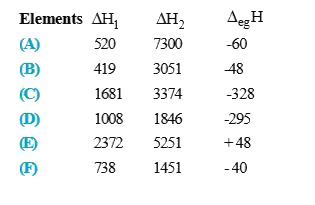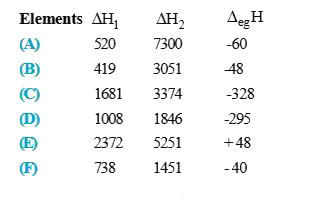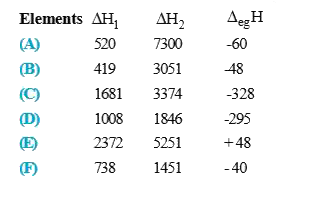Among the elements of second period pick out the element
that is the most reactive non- metal.
To determine the most reactive non-metal among the elements of the second period, we can follow these steps:
Step 1: Identify the Non-Metals in the Second Period
The second period of the periodic table includes the following elements:
- Lithium (Li)
- Beryllium (Be)
- Boron (B)
- Carbon (C)
- Nitrogen (N)
- Oxygen (O)
- Fluorine (F)
- Neon (Ne)
Among these, the non-metals are:
- Boron (B)
- Carbon (C)
- Nitrogen (N)
- Oxygen (O)
- Fluorine (F)
Step 2: Understand Reactivity of Non-Metals
Reactivity in non-metals generally increases with their electronegativity. Electronegativity is the ability of an atom to attract electrons towards itself. The higher the electronegativity, the more reactive the non-metal tends to be.
Step 3: Determine Electronegativity Values
Among the non-metals listed:
- Fluorine (F) has the highest electronegativity (approximately 4.0 on the Pauling scale).
- Oxygen (O) follows with an electronegativity of about 3.5.
- Nitrogen (N) has an electronegativity of about 3.0.
- Carbon (C) has an electronegativity of about 2.5.
- Boron (B) has an electronegativity of about 2.0.
Step 4: Conclusion
Since Fluorine has the highest electronegativity among the non-metals in the second period, it is the most reactive non-metal. Additionally, its electronic configuration (1s² 2s² 2p⁵) shows that it is only one electron short of achieving a stable noble gas configuration (1s² 2s² 2p⁶). This makes Fluorine eager to gain an electron, further increasing its reactivity.
Final Answer
The most reactive non-metal among the elements of the second period is Fluorine (F).
---
The second period of the periodic table includes the following elements:
- Lithium (Li)
- Beryllium (Be)
- Boron (B)
- Carbon (C)
- Nitrogen (N)
- Oxygen (O)
- Fluorine (F)
- Neon (Ne)
- Boron (B)
- Carbon (C)
- Nitrogen (N)
- Oxygen (O)
- Fluorine (F)
Reactivity in non-metals generally increases with their electronegativity. Electronegativity is the ability of an atom to attract electrons towards itself. The higher the electronegativity, the more reactive the non-metal tends to be.
Among the non-metals listed:
- Fluorine (F) has the highest electronegativity (approximately 4.0 on the Pauling scale).
- Oxygen (O) follows with an electronegativity of about 3.5.
- Nitrogen (N) has an electronegativity of about 3.0.
- Carbon (C) has an electronegativity of about 2.5.
- Boron (B) has an electronegativity of about 2.0.
Since Fluorine has the highest electronegativity among the non-metals in the second period, it is the most reactive non-metal. Additionally, its electronic configuration (1s² 2s² 2p⁵) shows that it is only one electron short of achieving a stable noble gas configuration (1s² 2s² 2p⁶). This makes Fluorine eager to gain an electron, further increasing its reactivity.
The most reactive non-metal among the elements of the second period is Fluorine (F).
Topper's Solved these Questions
- CLASSIFICATION OF ELEMENTS AND PERIODICITY IN PROPERTIESBOOK - ICSECHAPTER - CLASSIFICATION OF ELEMENTS AND PERIODICITY IN PROPERTIESEXERCISE - ESSAY (LONG ANSWER) TYPE QUESTIONS
27 Videos
- CLASSIFICATION OF ELEMENTS AND PERIODICITY IN PROPERTIESBOOK - ICSECHAPTER - CLASSIFICATION OF ELEMENTS AND PERIODICITY IN PROPERTIESEXERCISE - OBJECTIVE (MULTIPLE CHOICE) TYPE QUESTIONS
54 Videos
- CLASSIFICATION OF ELEMENTS AND PERIODICITY IN PROPERTIESBOOK - ICSECHAPTER - CLASSIFICATION OF ELEMENTS AND PERIODICITY IN PROPERTIESEXERCISE - VERY SHORT ANSWER TYPE QUESTIONS
25 Videos
- CHEMICAL THERMODYNAMICS BOOK - ICSECHAPTER - CHEMICAL THERMODYNAMICS EXERCISE - NCERT TEXT-BOOK. EXERCISES
22 Videos
- ENVIRONMENTAL CHEMISTRY BOOK - ICSECHAPTER - ENVIRONMENTAL CHEMISTRY EXERCISE - NCERT TEXT-BOOK EXERCISE
20 Videos
Similar Questions
Among the elements of second period pick out the element
that is the most reactive metal.
View SolutionAmong the elements of second period pick out the element
with the most negative electron gain enthalpy
View SolutionAmong the elements of second period pick out the element
with the most negative electron gain enthalpy
View SolutionAmong the elements of second period pick out the element
with the largest atomic radius.
View SolutionAmong the elements of the third period (Na to Ar), pick out the element
that is the most reactive non metal.
View SolutionAmong the elements of the third period (Na to Ar), pick out the element
that is the most reactive metal.
View SolutionThe first and second ionization enthalpies and electron gain enthalpy of some elements are as given below:

Which of these elements is the most reactive non-metal?
View SolutionAmong the elements of the third period (Na to Ar), pick out the element
with the largest atomic radius.
View SolutionThe first and second ionization enthalpies and electron gain enthalpy of some elements are as given below:

Which of these elements is the most reactive metal?
View SolutionThe first and second ionization enthalpies and electron gain enthalpy of some elements are as given below:

Which of these elements is the least reactive non-metal?
View Solution
